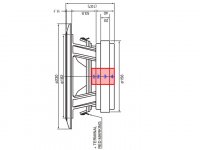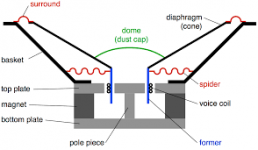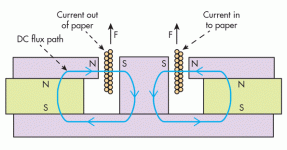Hi All - don't laugh, but where EXACTLY is the voice coil in my fostex 208ez (sigma)?! Please see attached image. Is it 1, 1&2, 1-3, 1-4, 2&3, 2-4, 3&4 etc?!
Sorry to be an idiot but I will be aligning an upward pointing tweeter with the voice coil and want to get its placement perfectly aligned with the voice coil of the full range driver.
Thanks!
Sorry to be an idiot but I will be aligning an upward pointing tweeter with the voice coil and want to get its placement perfectly aligned with the voice coil of the full range driver.
Thanks!
Attachments
The acoustic centre isn't the voice coil and I don't see the relevance under the circumstances?Sorry to be an idiot but I will be aligning an upward pointing tweeter with the voice coil and want to get its placement perfectly aligned with the voice coil of the full range driver.
The acoustic centre isn't the voice coil and I don't see the relevance under the circumstances?
Danny Richie at GR research advised I align with the voice coil if pointing the tweeter straight up.
Very likely, 4 is a solid plate of metal of it's whole thickness. So the end of the voicecoil will be driver side of that for sure.
You'll be wanting the middle of the length of the coil right? It's probably like an inch long or something.
According to the data sheet, the Xmax of the driver is only 1.25mm .. ( can that be right? Seems tiny).
I was going to say that it's Xmax would help work it out but that small depth of travel doesn't narrow it down much.
If you end up having to guess, go for half way between 2mm left #4 and the spider (which I guess is at the left side of #1). You might be able to trace the wires to see where they appear to start the coil after entering the side of the cone.
Would I be right in assuming the voice coil of an efficient driver is going to be long-ish, using up as much depth as possible?
You'll be wanting the middle of the length of the coil right? It's probably like an inch long or something.
According to the data sheet, the Xmax of the driver is only 1.25mm .. ( can that be right? Seems tiny).
I was going to say that it's Xmax would help work it out but that small depth of travel doesn't narrow it down much.
If you end up having to guess, go for half way between 2mm left #4 and the spider (which I guess is at the left side of #1). You might be able to trace the wires to see where they appear to start the coil after entering the side of the cone.
Would I be right in assuming the voice coil of an efficient driver is going to be long-ish, using up as much depth as possible?
Last edited:
Me neither, acoustically, but maybe the guy advising is talking about close proximity and minimising interference with the magentic field of the other driver? Preventing a stronger field one side or other of the voice coil of the Fostex by aligning it with the middle of the Fostex's coil?
Last edited:
In that case NATDBERG, wouldn't the advisor simply recommend aligning the axis of the upward facing tweeter with the mid point of the magnet (part 3) in the Fostex?
P.S. I think we're saying the same thing - you meant to say 'tweeter's coil' at the end of your sentence.
P.S. I think we're saying the same thing - you meant to say 'tweeter's coil' at the end of your sentence.
Last edited:
Hi All - don't laugh, but where EXACTLY is the voice coil in my fostex 208ez (sigma)?! Please see attached image. Is it 1, 1&2, 1-3, 1-4, 2&3, 2-4, 3&4 etc?!
Sorry to be an idiot but I will be aligning an upward pointing tweeter with the voice coil and want to get its placement perfectly aligned with the voice coil of the full range driver.
Thanks!
It´s exactly on area "2" and probably a couple mm longer than plate thickness.
If you are obsessed with alignment
the Xmax of the driver is only 1.25mm .. ( can that be right? Seems tiny).
It´s a Full Range speaker so it needs to reach high on its own, as I mention above voice coil will be "about 2 mm longerthan gap height" which is front plate thickness.
Typical front plate thickness for such a speaker will be 5 or 6 mm or at most 8 mm (unlikely)
Add 2 or 3 mm to that and that´s a proper VC winding length.
Long and heavy VCs are acceptable on woofers but not here.
Last edited:
You're wasting your time worrying about acoustic centres if you're using with an up-firing tweeter since whatever other merits they may have, one thing ambient tweeters are not about is accurate phase alignment. 
Note that there are numerous ways of deriving a number for Xmax (I gave up counting the different wild & wonderful variations at 10), all of which provide different figures if applied to the same drive unit. It's an invented number that does not actually tell you much useful about performance in any of its variations. Many drive units (like the Fostex) have rather more physical travel available to them until they reach the mechanical limit (Xmech). Not all, but many. Depends what method was used to create a value for Xmax in the first place, whether it's an under or overhung motor design &c.
Note that there are numerous ways of deriving a number for Xmax (I gave up counting the different wild & wonderful variations at 10), all of which provide different figures if applied to the same drive unit. It's an invented number that does not actually tell you much useful about performance in any of its variations. Many drive units (like the Fostex) have rather more physical travel available to them until they reach the mechanical limit (Xmech). Not all, but many. Depends what method was used to create a value for Xmax in the first place, whether it's an under or overhung motor design &c.
Last edited:
You're wasting your time worrying about acoustic centres if you're using with an up-firing tweeter since whatever other merits they may have, one thing ambient tweeters are not about is accurate phase alignment.
Note that there are numerous ways of deriving a number for Xmax (I gave up counting the different wild & wonderful variations at 10), all of which provide different figures if applied to the same drive unit. It's an invented number that does not actually tell you much useful about performance in any of its variations. Many drive units (like the Fostex) have rather more physical travel available to them until they reach the mechanical limit (Xmech). Not all, but many. Depends what method was used to create a value for Xmax in the first place, whether it's an under or overhung motor design &c.
I trust Danny's advice and will be aligning as closely as possible with the voice coil.
In that case NATDBERG, wouldn't the advisor simply recommend aligning the axis of the upward facing tweeter with the mid point of the magnet (part 3) in the Fostex?
P.S. I think we're saying the same thing - you meant to say 'tweeter's coil' at the end of your sentence.
Ah no, I did mean the Fostex's .
I was thinking that the spring forces of the spider would be a kind of best-fit for the averaging of magnetic forces the coil experiences over it's whole travel (which in this driver is so small.. so it might not make any difference). If you strengthen (or weaken?) that field by placing another magent nearby and intereacting with it, that spider will be kind of out of spec for its new environment. Again, I would have thought - I'm no expert at all.
By placing the new field at the centre of the coil, at least you make the extra forces neutral on the coil at it's equilibrium point.
However, I'd bet the difference between one and the other is likely tiny and it's DIY too so maybe there will be a certain error that is larger !
For the sake of ease and not being pointlessly anal about it, yep, probably just align with the centre of the magnet.
JMF is correct, of course, and I submit this attachment as reference.
OK, now I see what JMF was saying..
Thanks for that, both.
Now I'd like to see a diagram of magnetic field created by the common speaker magnet/plate arrangements... any clues where to see one?
Last edited:
OK, now I see what JMF was saying..
Thanks for that, both.
Now I'd like to see a diagram of magnetic field created by the common speaker magnet/plate arrangements... any clues where to see one?
Magnetic interference won't be an issue where I'll be placing the FR driver and tweeter.
In your diagram of the Fostex, if you trace back the cone profile you will see that the apex of the cone coincides with the midpoint of the voice coil (midpoint of area 2).I trust Danny's advice and will be aligning as closely as possible with the voice coil.
So you're good to go in terms of acoustic alignment (although above 3kHz phase differences are unlikely to constitute a problem with an upward facing tweeter).
I've don't know of him. Coincidentally someone posted this link today,I trust Danny's advice and will be aligning as closely as possible with the voice coil.
YouTube others here might find his view points interesting
Here's a diagram showing how the magnetic flux is contained/directed within the motor system.Now I'd like to see a diagram of magnetic field created by the common speaker magnet/plate arrangements... any clues where to see one?
Attachments
I've don't know of him. Coincidentally someone posted this link today,
YouTube others here might find his view points interesting
That's the Danny I've been emailing. He posted a different video recently which prompted this placement decision.
- Status
- This old topic is closed. If you want to reopen this topic, contact a moderator using the "Report Post" button.
- Home
- Loudspeakers
- Full Range
- Where the heck is the voice coil..... exactly?!


